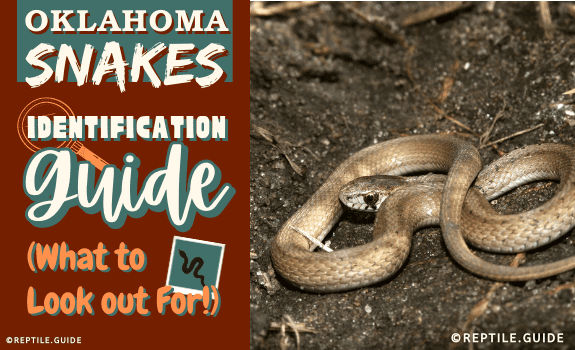There are many different Oklahoma snakes with widely ranging forms and sizes. Big, small, brown, black, orange, dangerous, harmless, Oklahoma has it all.
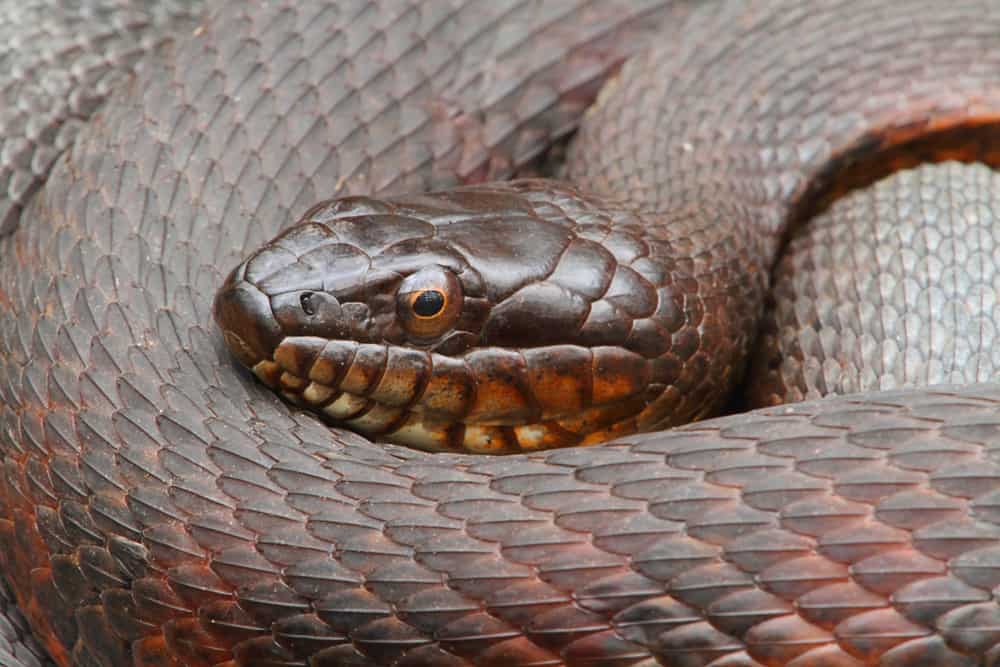
We’ll take a look at everything from the harmless water snakes in Oklahoma to the enormous, and highly venomous, timber rattlesnakes.
In This Article
In Short
In this guide, I’ll teach you about:
- Oklahoma snake identification
- Common snakes native to Oklahoma
- How to deal with snakes when you find them
- Identifying venomous (often called poisonous) snakes in Oklahoma
I’ll also share pictures of many Oklahoman snake species, and useful resources for educating yourself about and dealing with snakes.
Oklahoma Snake Identification Basics
When you’re learning to identify snakes, amphibians, or other animals, there are a few characteristics to bear in mind. These are the snake’s
- Size
- Color and Pattern
- Head and Pupil Shape
- Locality and Habitat Type
Below, I’ll explain how each of these works, and why it’s important.
Length
Most snakes only reach a certain length, which is the average length for the species.
In exceptional cases, a snake species might reach larger sizes than it usually would – this is known as the maximum length.
By knowing both the average and maximum length for a species, you can easily rule out many species.
For example, the small brown snakes are impossible to confuse for the large garter snakes or timber rattlesnakes.
Locality and Habitat Type
As with a snake’s size, most snakes have an average or preferred habitat type. You won’t find water snakes in dry, sandy areas, but you won’t find hog-nosed snakes outside of them.
Taking note of the habitat type might be the key to identifying a species when two possibilities reach similar sizes and have similar distribution ranges.
Speaking of distribution ranges, the geographical location where you discover a snake also plays a part in identifying them.
Most animal species have a well-defined distribution range. By looking at the distribution maps for any particular species, you can easily discern if it occurs in the area where you found a snake.
Head and Pupil Shape
Different groups of snake species have different head shapes. By taking note of the shape, you can easily discern whether a snake belongs to a certain group.
For instance, pit vipers have diamond-shaped or triangular heads. Harmless snakes like the black rat snake and black-necked garter snake have heads that are shaped much like the rest of their bodies.
Snakes also have various pupil shapes, specifically:
- Round
- Vertical
- Horizontal
In Oklahoma, you’re only likely to encounter round and vertical pupils.
All the venomous snakes found in Oklahoma have vertical, slit-shaped pupils. All other species have round pupils.
Color and Patterning
While the coloration and patterning of a species can vary significantly, these visual cues are still essential for positive identification.
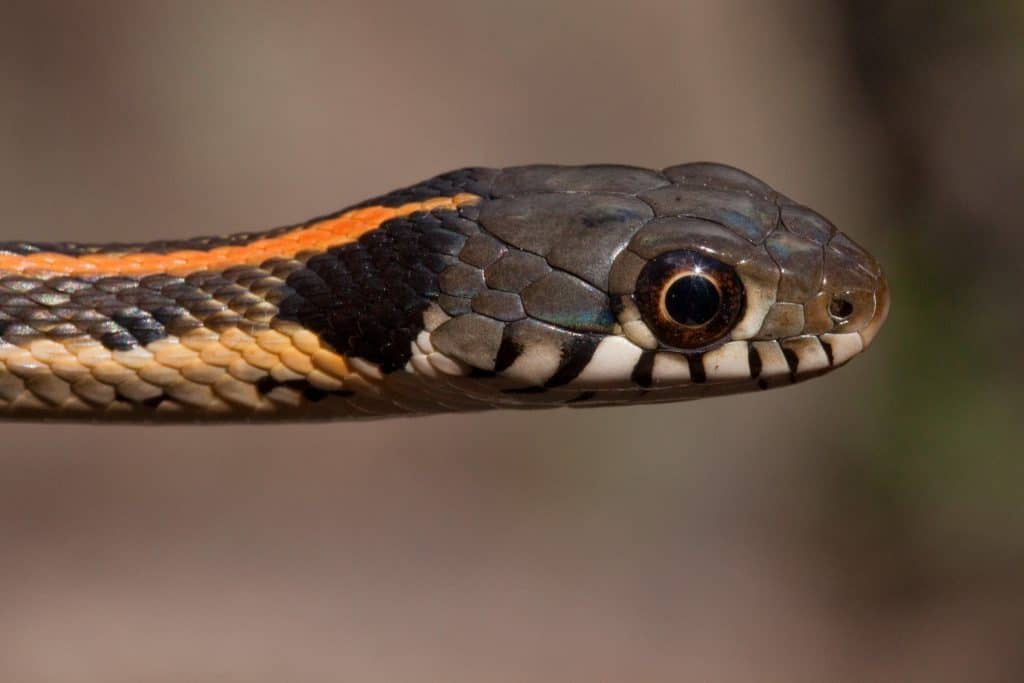
Image credit: aspidoscelis (via CreativeCommons.org)
For example, if you see black snakes in Oklahoma they definitely won’t be rough green snakes or ring-necked snakes. However, they can easily be black rat snakes.
Brown snakes with blotches or bands are impossible to confuse for the plain black of worm snakes.
While trying to identify a snake using a single identification characteristic can quickly lead you astray, noting multiple characteristics leads to accurate identification.
Quickly Identifying Venomous Snake Species
Since there are only seven or eight venomous species in Oklahoma, they’re fairly easy to identify.
All of these potentially dangerous species are pit vipers, which makes telling them apart even easier. They all share the following characteristics:
- Slit-shaped pupils
- A rattle-like tail adaption (in rattlesnakes)
- Heat sensing pits between the eyes and nostrils
- Large, wide heads with a diamond-like or triangular shape
- Neutral coloration that will blend well with leaf litter or rocky areas
- A thick, robust body shape – irrespective of the snake’s overall length
Which Snakes Live in Oklahoma?
The snakes of Oklahoma include several venomous species, most of which belong to the pit viper group. No substantiated claims exist of the coral snake occurring in the region.
- The Pit Viper Family
- Eastern Copperhead – Agkistrodon contortrix
- Northern Cottonmouth – Agkistrodon piscivorus
- Broad-banded Copperhead – Agkistrodon laticinctus
- Pygmy Rattlesnake – Sistrurus miliarius
- Western Massasauga – Sistrurus tergeminus
- Prairie Rattlesnake – Crotalus viridis
- Timber Rattlesnake – Crotalus horridus
- Western Diamond-backed Rattlesnake – Crotalus atrox
Most of the non-venomous snakes fit into one of the following main groupings:
- Hog-nosed Snakes
- Plains Hog-nosed Snake – Heterodon nasicus
- Eastern Hog-nosed Snake – Heterodon platirhinos
- Kingsnakes and Milksnakes
- Prairie Kingsnake – Lampropeltis calligaster
- Western Milksnake – Lampropeltis gentilis
- Speckled Kingsnake – Lampropeltis holbrooki
- Watersnakes
- Broad-Banded Watersnake – Nerodia fasciata
- Common Watersnake – Nerodia sipedon
- Plain-bellied Watersnake – Nerodia erythrogaster
- Diamondback Watersnake – Nerodia rhombifer
- Rat snakes and Cornsnakes
- Black Rat Snake – Pantherophis obsoletus
- Slowinski’s Cornsnake – Pantherophis slowinskii
- Great Plains Rat Snake – Pantherophis emoryi
- Blind Snakes
- Texas Blind Snake – Rena dulcis
- New Mexico Blind Snake – Rena dissecta
- Brownsnakes
- Red-bellied Snake – Storeria occipitomaculata
- Dekay’s Brownsnake – Storeria dekayi
- Crowned Snakes
- Flat-headed Snake – Tantilla gracilis
- Plains Black-headed Snake – Tantilla nigriceps
- Garter Snakes
- Plains Garter Snake – Thamnophis radix
- Western Ribbon Snake – Thamnophis proximus
- Common Garter Snake – Thamnophis sirtalis
- Checkered Garter Snake – Thamnophis marcianus
- Black-necked Garter Snake – Thamnophis cyrtopsis
The rest of the non-venomous species are singular representatives of their genera. They include the following:
- Mudsnake – Farancia abacura
- Coachwhip – Masticophis flagellum
- Lined Snake – Tropidoclonion lineatum
- Scarletsnake – Cemophora coccinea
- Glossy Snake – Arizona elegans
- Ground Snake – Sonora semiannulata
- Gopher Snake – Pituophis catenifer
- Rough Earth Snake – Haldea striatula
- Long-nosed Snake – Rhinocheilus lecontei
- Ring-necked Snake – Diadophis punctatus
- Rough Green Snake – Opheodrys aestivus
- Smooth Earth Snake – Virginia valeriae
- Glossy Swampsnake – Liodytes rigida
- Western Worm Snake – Carphophis vermis
- North American Racer – Coluber constrictor
- Chihuahuan Nightsnake – Hypsiglena jani
- Graham’s Crayfish Snake – Regina grahamii
Most Common Snakes in Oklahoma
According to iNaturalist, the most common snakes in Oklahoma include the following species:
- Western Rat Snake – Pantherophis obsoletus
- Plain-bellied Watersnake – Nerodia erythrogaster
- Dekay’s Brownsnake – Storeria dekayi
- Ring-necked Snake – Diadophis punctatus
- Western Ribbon Snake – Thamnophis proximus
- Rough Earthsnake – Haldea striatula
- Diamondback Watersnake – Nerodia rhombifer
- Rough Green Snake – Opheodrys aestivus
- Northern Cottonmouth – Agkistrodon piscivorus
- North American Racer – Coluber constrictor
Rat Snakes
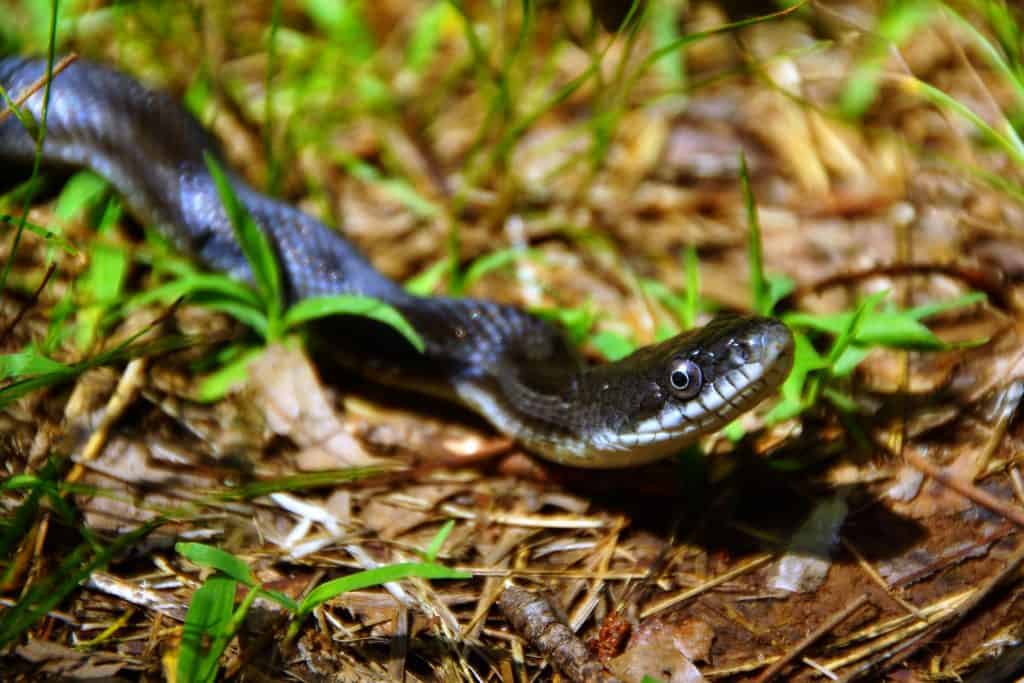
Image credit: Stephen Little (via CreativeCommons.org)
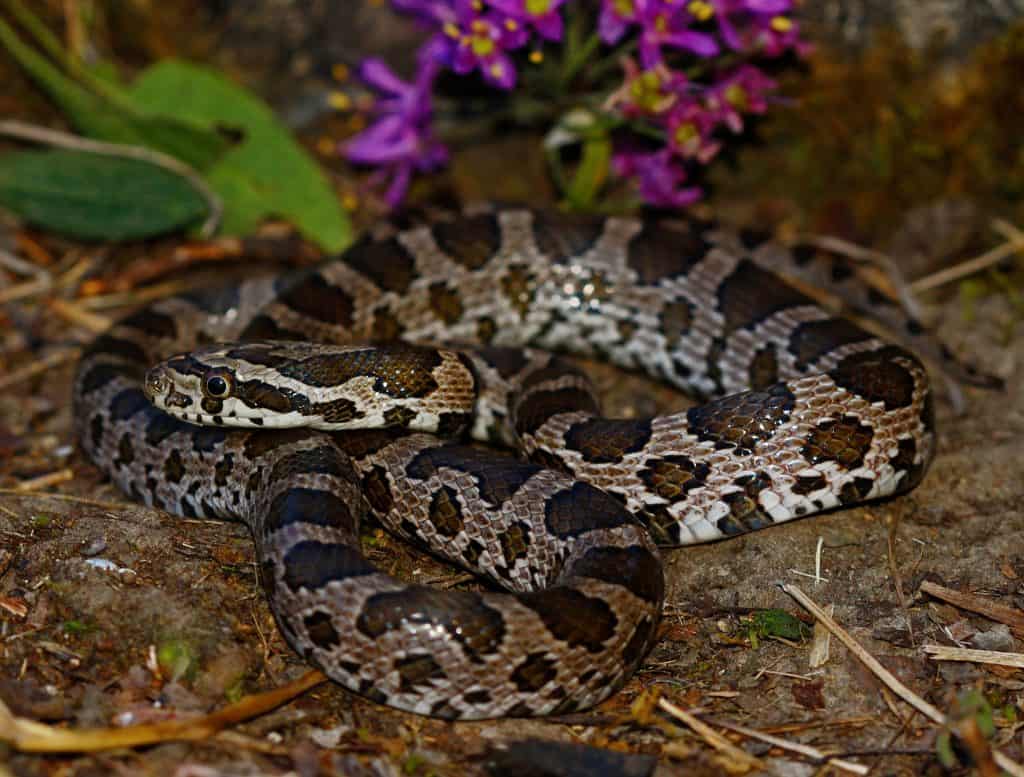
Image credit: 2ndPeter (via CreativeCommons.org)
The rat snake in Oklahoma is a common species, and rat snakes are common inhabitants of most of the United States.
These non-venomous snakes are useful controllers of the rodent population.
|
Scientific Name: |
Black Rat Snake – Pantherophis obsoletus Slowinski’s Cornsnake – Pantherophis slowinskii Great Plains Rat Snake – Pantherophis emoryi |
|---|---|
|
Range: |
Throughout the state |
|
Adult Size: |
Pantherophis emoryi – 23-49 inches Pantherophis slowinskii – 3-5 feet Pantherophis obsoletus – 3-6 feet |
|
Description: |
Muscular bodies, typical of constrictors, taper down to a sharp, pointed tail. The heads are long, and the same width as the body, with round pupils. Colors range from black to brown with darker brown markings. |
|
Habitat: |
Habitat generalists, living where food is most abundant |
|
Venomous/Non-Venomous: |
Non-venomous |
Brownsnakes
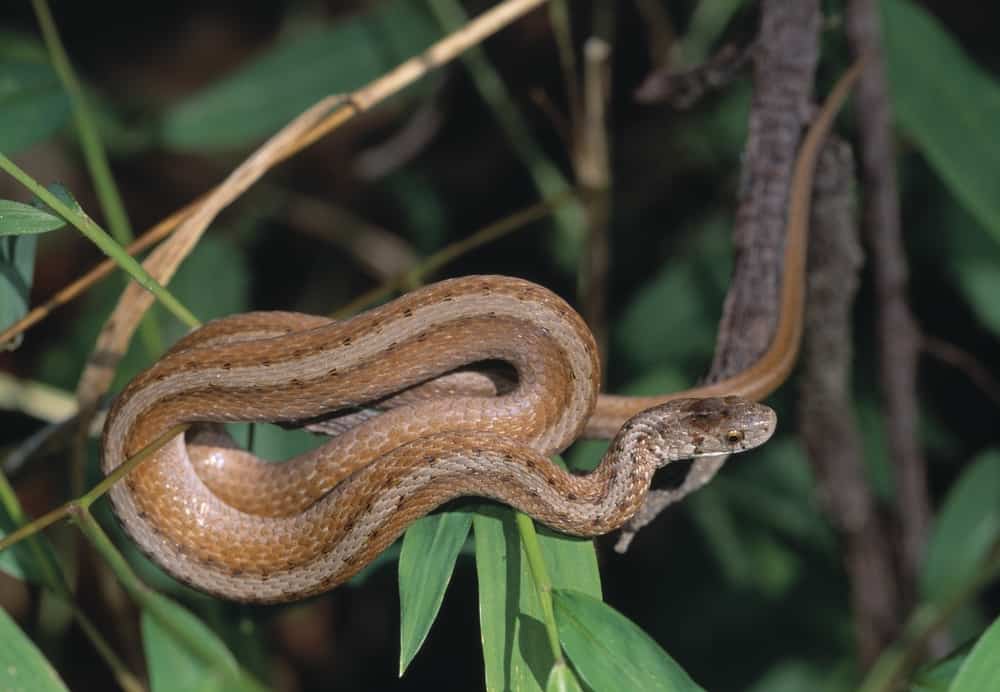
The Brownsnake, or brown snake, in Oklahoma is a common resident of forested areas with moist soils. The red-bellied snake is a close relative with similar habits.
|
Scientific Name: |
Red-bellied Snake – Storeria occipitomaculata Dekay’s Brownsnake – Storeria dekayi |
|---|---|
|
Range: |
Central and Eastern Oklahoma |
|
Adult Size: |
Storeria dekayi – 6-13 inches Storeria occipitomaculata – 4-10 inches |
|
Description: |
Small brown snakes with a light vertebral stripe. A bright red belly (in the case of S. occipitomaculata). Long tails and short heads with round pupils. |
|
Habitat: |
Highly adaptable, but prefers areas with moist soils |
|
Venomous/Non-Venomous: |
Non-venomous |
Water Snakes in Oklahoma
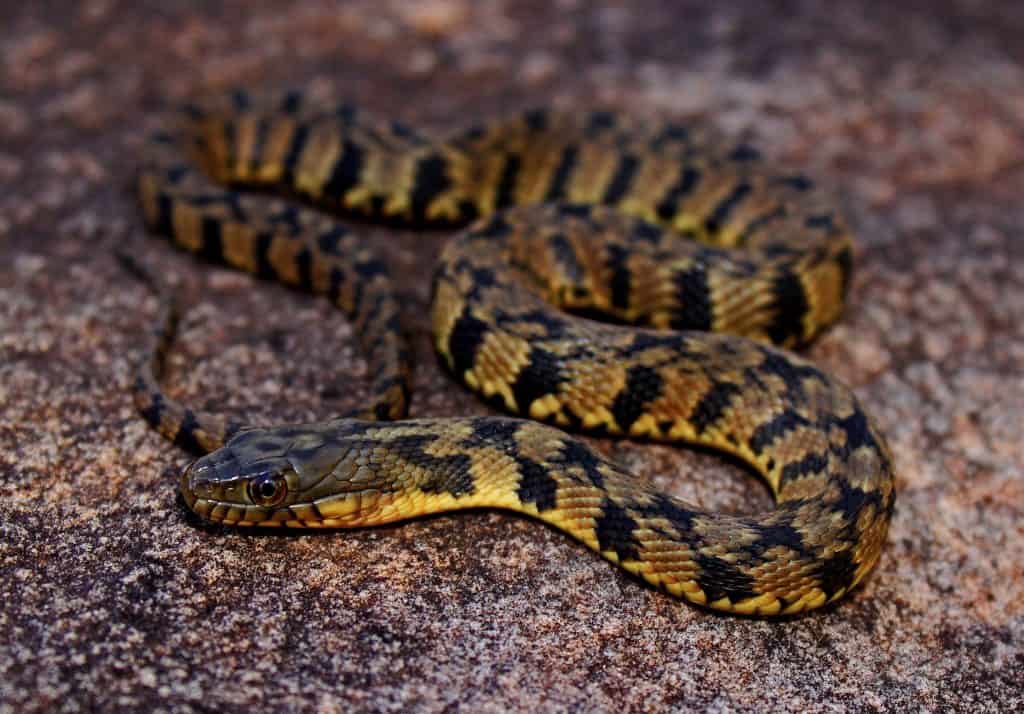
Image credit: 2ndPeter (via CreativeCommons.org)
Water snakes are common animals around water sources like rivers and marshes. They feed mainly on fish and amphibian prey.
|
Scientific Name: |
Common Watersnake – Nerodia sipedon Plain-bellied Watersnake – Nerodia erythrogaster Diamondback Watersnake – Nerodia rhombifer Broad-Banded Watersnake – Nerodia fasciata |
|---|---|
|
Range: |
Throughout the state |
|
Adult Size: |
Nerodia sipedon – 24-55 inches Nerodia erythrogaster – 30-40 inches Nerodia rhombifer – 30-48 inches Nerodia fasciata – 24-48 inches |
|
Description: |
Large robust snakes with large, glossy scales. Sharply pointed faces and large eyes with round pupils. Colors range from back to brown and green. |
|
Habitat: |
Anywhere near freshwater sources like rivers, swamps, and marshes |
|
Venomous/Non-Venomous: |
Non-venomous |
Garter Snakes
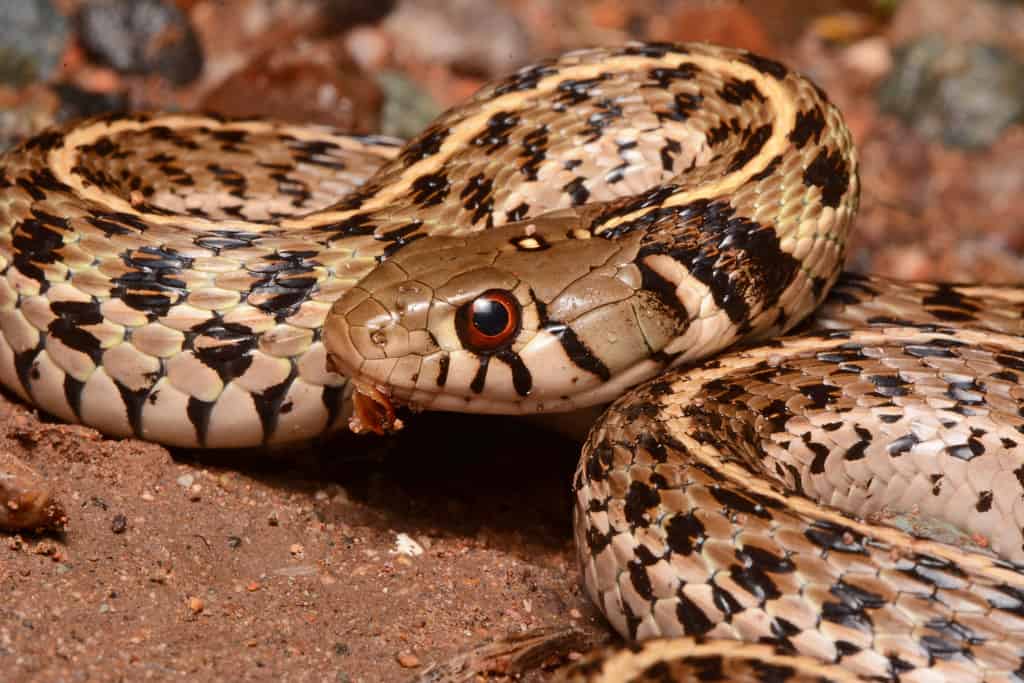
Image credit: amdubois01 (via CreativeCommons.org)
Unlike many other snakes, the garter snakes and ribbon snakes are habitat generalists. They live anywhere where the small mammals they feed on are abundant.
|
Scientific Name: |
Plains Garter Snake – Thamnophis radix Western Ribbon Snake – Thamnophis proximus Common Garter Snake – Thamnophis sirtalis Checkered Garter Snake – Thamnophis marcianus Black-necked Garter Snake – Thamnophis cyrtopsis |
|---|---|
|
Range: |
Throughout the state |
|
Adult Size: |
Thamnophis radix – 16-28 inches Thamnophis sirtalis – 18-49 inches Thamnophis cyrtopsis – 35-42 inches Thamnophis proximus – 17-50 inches Thamnophis marcianus – 20-28 inches |
|
Description: |
Very long, narrow snakes in various shades of brown and black. They have muscular, but not thick bodies typical of semi-arboreal species. May be brown or black with or without stripes and spots in brown, black or yellow. Often have between one and three vertical stripes flanked by small speckles. |
|
Habitat: |
Diverse, often grasslands and prairies |
|
Venomous/Non-Venomous: |
Non-venomous |
Ring-Necked Snake
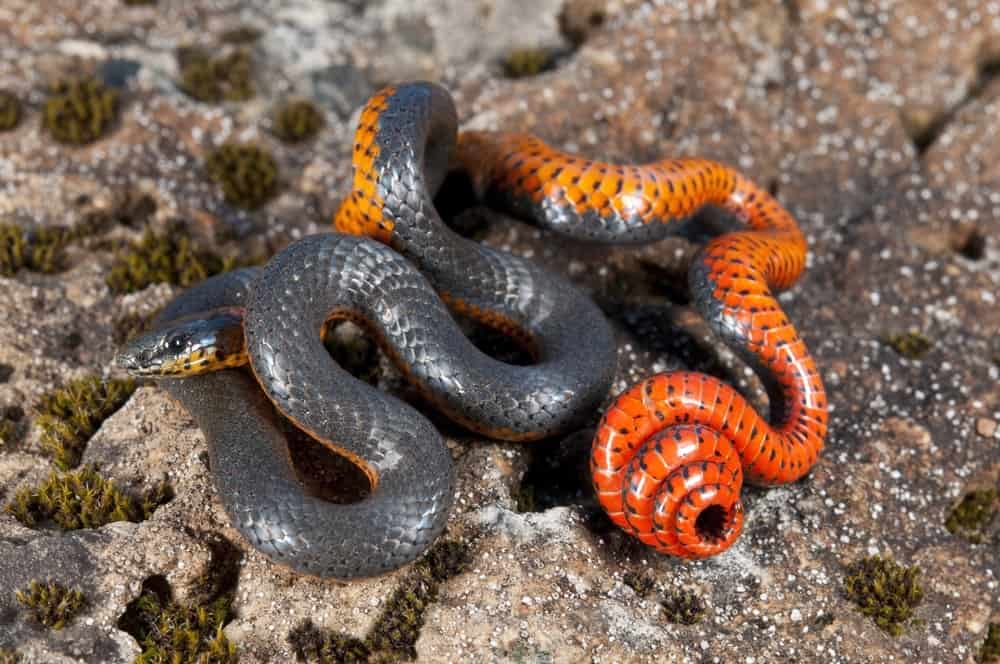
The ring-necked or ringneck snake is a striking species with a bright orange belly that serves to warn off predators.
|
Scientific Name: |
Diadophis punctatus |
|---|---|
|
Range: |
Throughout the state |
|
Adult Size: |
10-15 inches |
|
Description: |
A small, but muscular, snake with a black upperside and a bright red or orange belly. A short head that follows directly upon a bright ring around the snake’s neck. The tail is long, with a rounded point, and the pupils are round. |
|
Habitat: |
Diverse, but prefers habitats with wooded areas |
|
Venomous/Non-Venomous: |
Non-venomous |
North American Racer
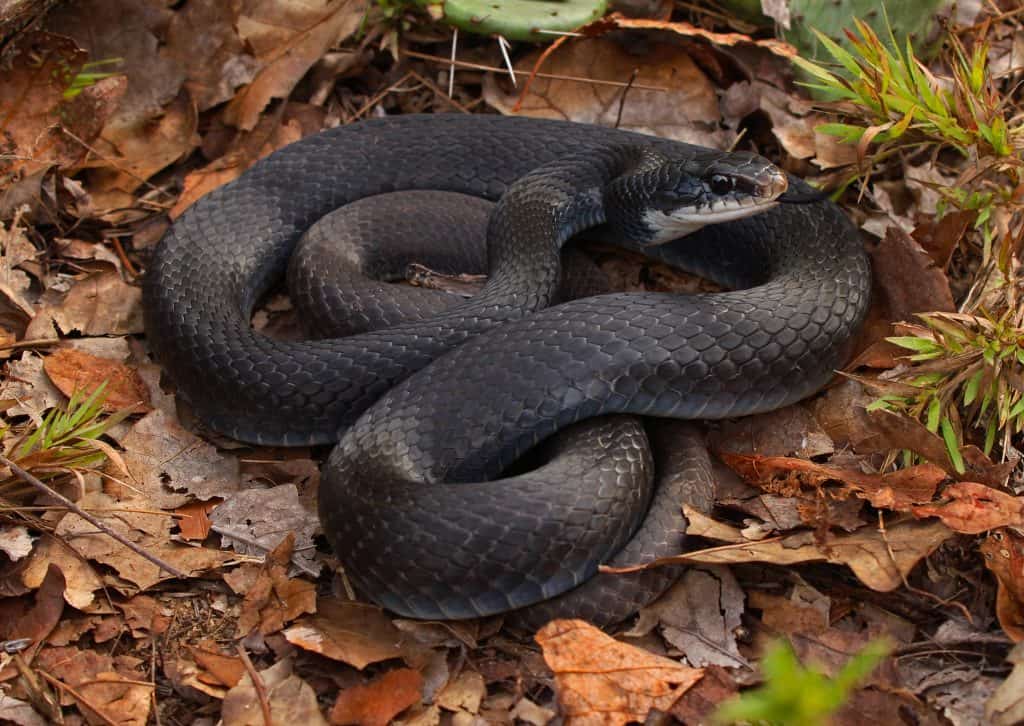
Image credit: 2ndPeter (via CreativeCommons.org)
The North American Racer, Black Racer, or Blue Racer, is one of the longest snakes on the North American continent.
|
Scientific Name: |
Coluber constrictor |
|---|---|
|
Range: |
Throughout the state |
|
Adult Size: |
36-60 inches |
|
Description: |
A blue, black, or sometimes brownish snake with a white throat and underside. It’s a long snake with large, diamond-shaped scales. The head is pronounced, thanks to the white throat, and the snake’s pupils are round. |
|
Habitat: |
Habitat generalists, living in any food-rich areas |
|
Venomous/Non-Venomous: |
Non-venomous |
Rough Green Snake
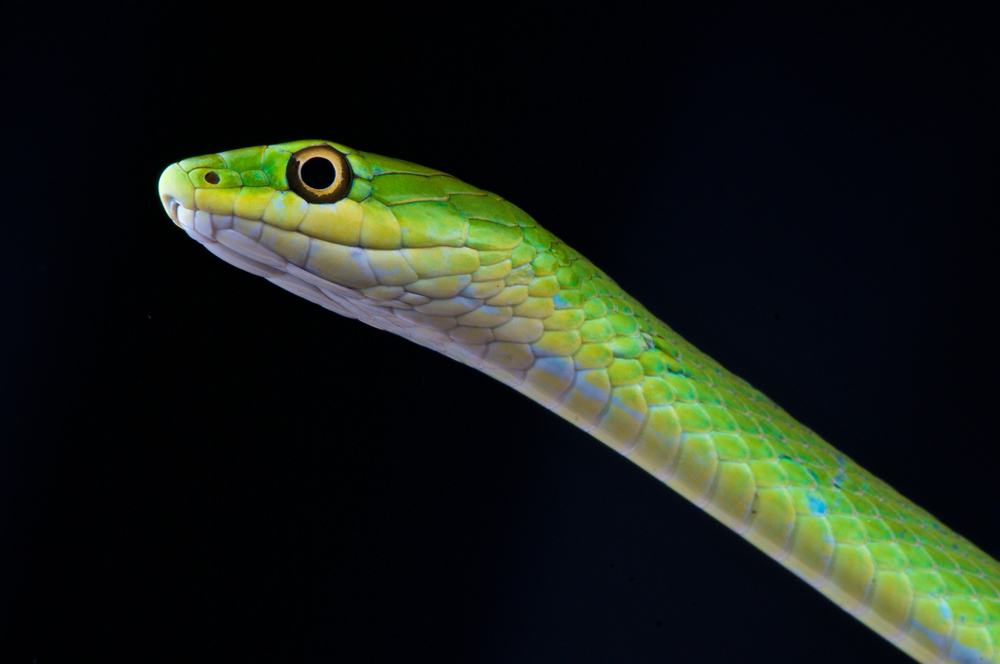
The Rough Green Snake, sometimes known as a grass snake, is vibrant green and blends well into any form of green vegetation.
|
Scientific Name: |
Opheodrys aestivus |
|---|---|
|
Range: |
Central and Eastern Oklahoma |
|
Adult Size: |
Up to 32 inches |
|
Description: |
A long green snake with a thin body typical of arboreal species. The underside is white or yellow and clearly visible around halfway down the snake’s side. The large eyes have round pupils and conspicuous orange irises. |
|
Habitat: |
Moist meadows and woodlands |
|
Venomous/Non-Venomous: |
Non-venomous |
Rough Earth Snake
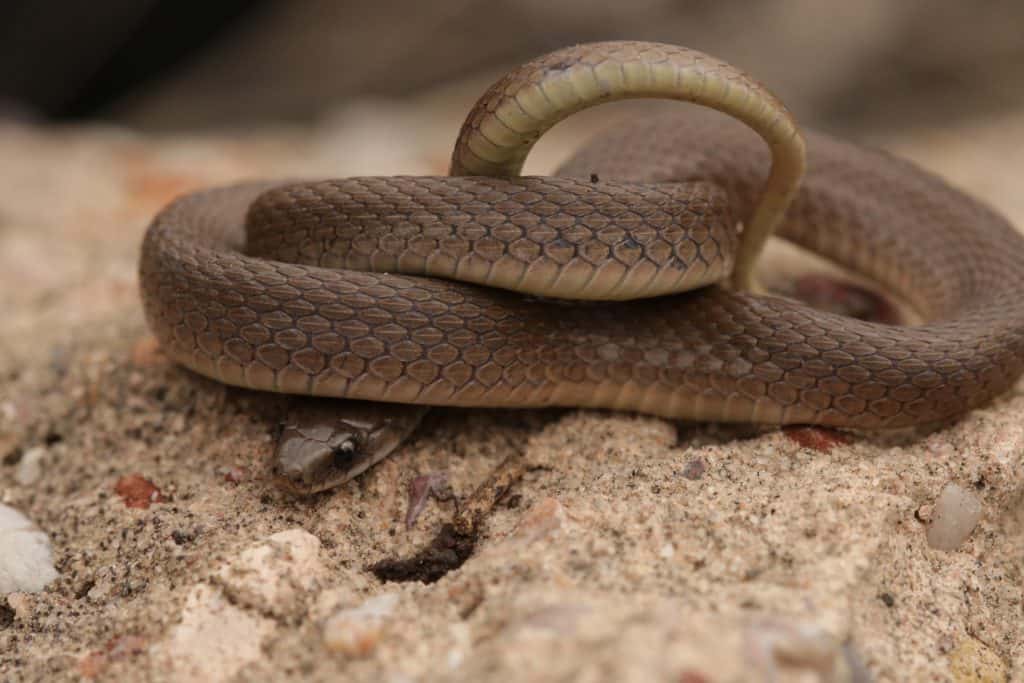
Image credit: u/frank_g1234 (via Reddit.com)
The rough earth snake gets its name from its slightly raised scales and earthy coloration.
|
Scientific Name: |
Haldea striatula |
|---|---|
|
Range: |
Central and Eastern Oklahoma |
|
Adult Size: |
7-10 inches |
|
Description: |
A small brown snake with rough-looking, slightly keeled scales. It has a relatively short head and the pupils are round. The underside is a light yellow-brown color. |
|
Habitat: |
Habitat generalist, thriving where food is abundant |
|
Venomous/Non-Venomous: |
Non-venomous |
Venomous Snakes in Oklahoma
Of the 44 snake species in Oklahoma, only seven species with venom are common. However, there are eight venomous types in all. They are the:
- Eastern Copperhead – Agkistrodon contortrix
- Northern Cottonmouth – Agkistrodon piscivorus
- Broad-banded Copperhead – Agkistrodon laticinctus
- Pygmy Rattlesnake – Sistrurus miliarius
- Western Massasauga – Sistrurus tergeminus
- Prairie Rattlesnake – Crotalus viridis
- Timber Rattlesnake – Crotalus horridus
- Western Diamond-backed Rattlesnake – Crotalus atrox
Eastern Copperhead
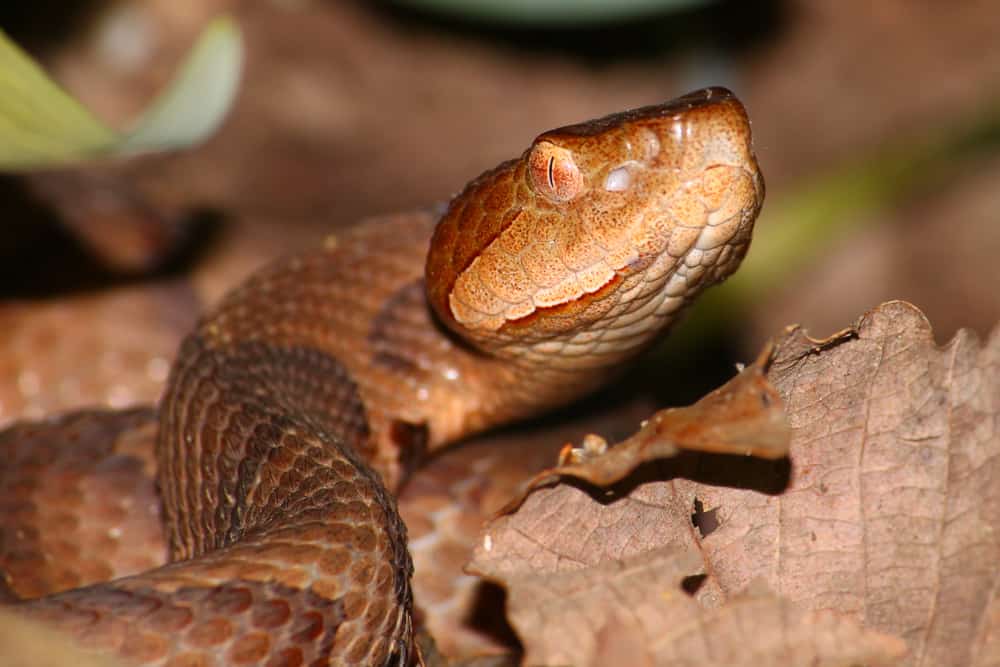
|
Scientific Name: |
Agkistrodon contortrix |
|---|---|
|
Range: |
Throughout Central and Eastern Oklahoma |
|
Adult Size: |
24-40 inches |
|
Description: |
The snake has a wide, triangular head with large eyes and heat-sensing pits between the eyes and nostrils. The snake’s pupils are elliptical. The robust body is marked in various shades of brown, and the head has a coppery-bronze color. A lighter band of color runs down each side of the head. |
|
Habitat: |
Deciduous forests, woodlands, and other wooded areas |
|
Venomous/Non-Venomous: |
Venomous |
Broad-banded Copperhead
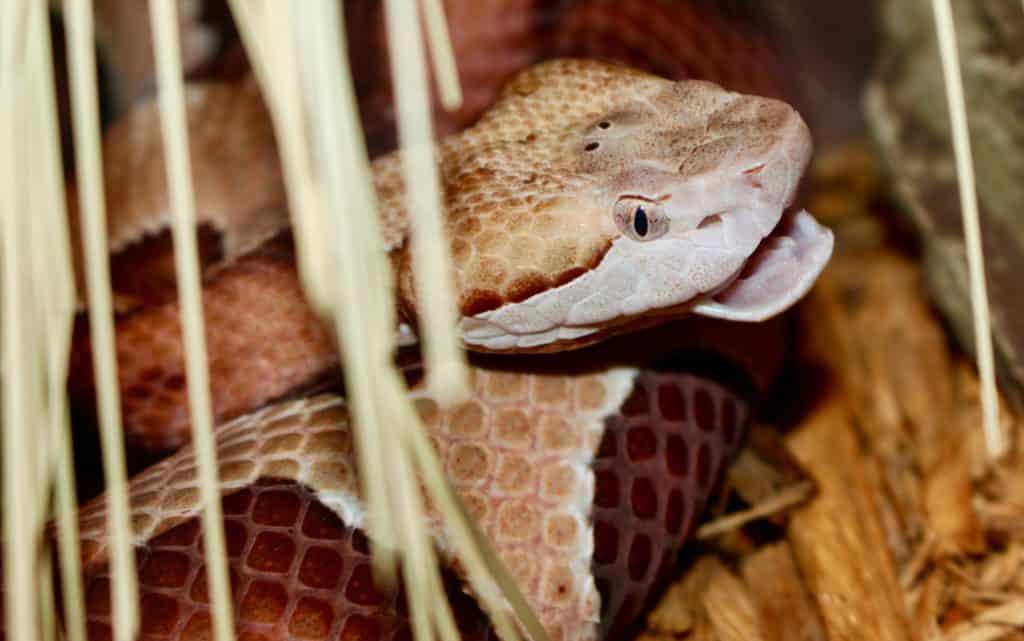
Image credit: auntiepauline (via CreativeCommons.org)
|
Scientific Name: |
Agkistrodon laticinctus |
|---|---|
|
Range: |
Central and Eastern Oklahoma |
|
Adult Size: |
20-30 inches |
|
Description: |
Similar to the copperhead, except that it’s smaller, lighter in color, and with broader bands. |
|
Habitat: |
This nocturnal snake prefers wooded habitats of various types |
|
Venomous/Non-Venomous: |
Venomous |
Northern Cottonmouth
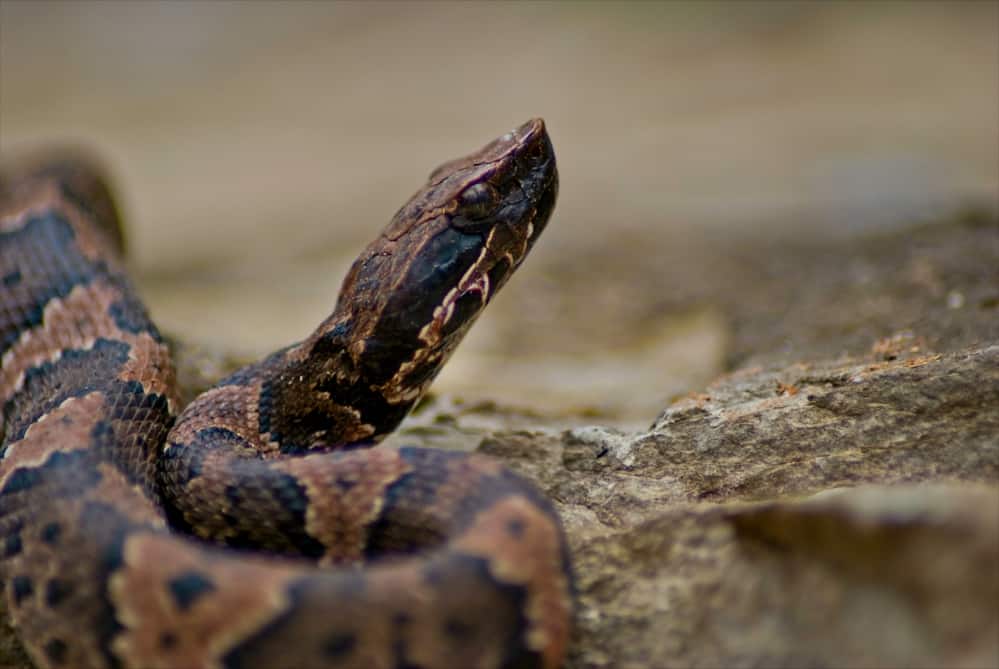
|
Scientific Name: |
Agkistrodon piscivorus |
|---|---|
|
Range: |
Eastern and South-Central Oklahoma |
|
Adult Size: |
26-35 inches |
|
Description: |
A medium-sized snake with a robust body and a wide, triangular head. The snake is brown with alternating, dark brown patches. The sides of the head are horizontally striped in various shades of brown and black. Large eyes with slit-shaped pupils, and the face has heat-sensing pits between the eyes and nostrils. The inside of the mouth is creamy white, giving the snake its name. |
|
Habitat: |
Anywhere near freshwater, but mainly swamps and marshes |
|
Venomous/Non-Venomous: |
Venomous |
Pygmy Rattlesnake
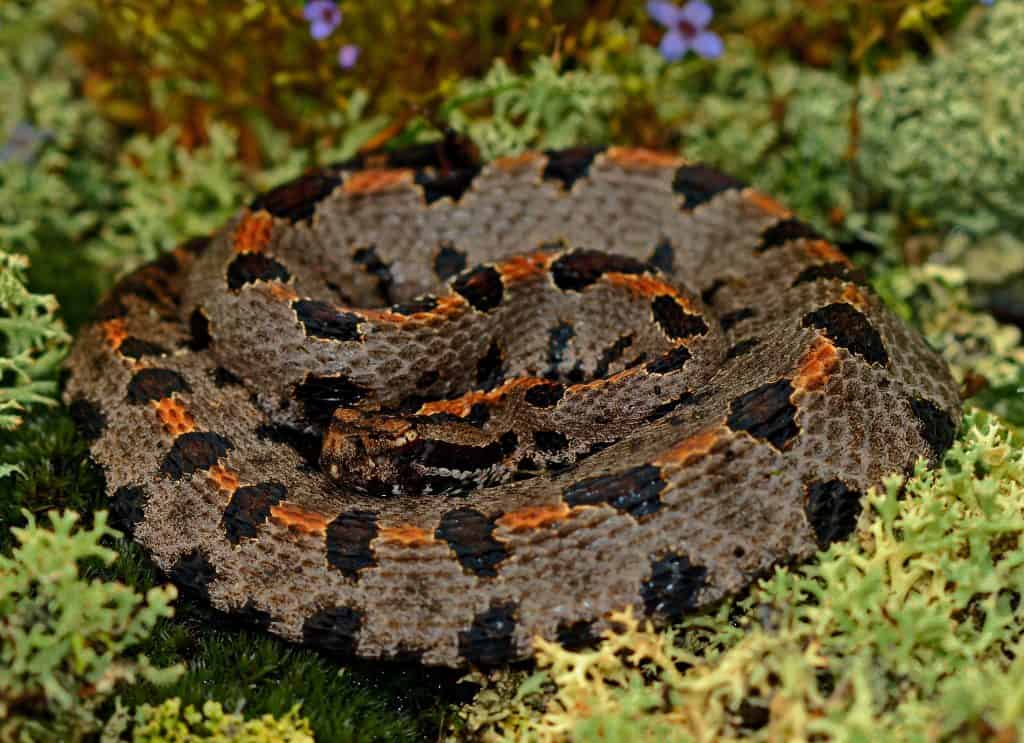
Image credit: 2ndPeter (via CreativeCommons.org)
|
Scientific Name: |
Sistrurus miliarius |
|---|---|
|
Range: |
Southeastern and South-Central Oklahoma |
|
Adult Size: |
14-22 inches |
|
Description: |
Tail adapted to form a rattle. The smallest rattler in the region. Large, non-raised eyes with vertical pupils. Big heat-sensing pits between the eyes and nostrils. Light brown with darker brown markings that are less chaotic than those of the Massasauga. A broad-ish, triangular-shaped head with brown and tan stripes down the sides. |
|
Habitat: |
Diverse, including flatlands, sandhills, and areas near swamps or marshes |
|
Venomous/Non-Venomous: |
Venomous |
Western Massasauga
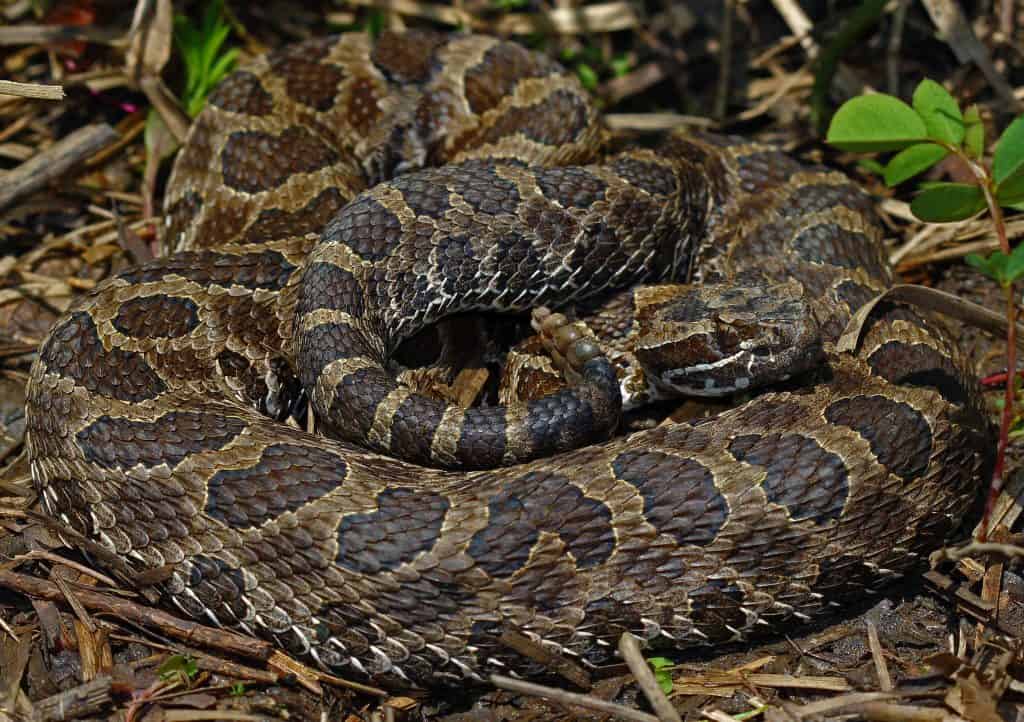
Image credit: 2ndPeter (via CreativeCommons.org)
|
Scientific Name: |
Sistrurus tergeminus |
|---|---|
|
Range: |
Northern and Northwestern Oklahoma |
|
Adult Size: |
14-36 inches |
|
Description: |
The final scales of the tail have adapted to form a rattle. A small, medium-dark brown snake with multiple series of darker blotches. The large head is somewhat narrower than the Crotalus rattlesnakes, but still roughly triangular in shape. White and brown stripes run down the sides of the snake’s face. Large eyes with slit-shaped pupils, not horned or raised in any way. Heat-sensing pits between the nostrils and the eyes. |
|
Habitat: |
Grasslands, hillsides, and the edges of woodlands |
|
Venomous/Non-Venomous: |
Venomous |
Prairie Rattlesnake
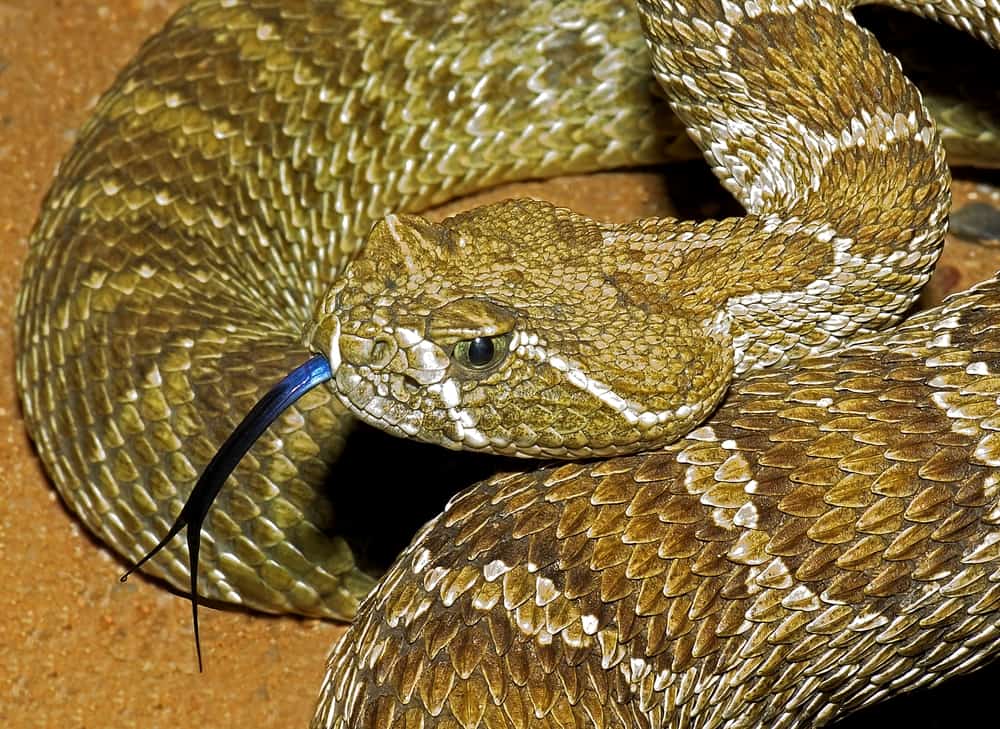
|
Scientific Name: |
Crotalus viridis |
|---|---|
|
Range: |
Throughout Western Oklahoma |
|
Adult Size: |
35-45 inches |
|
Description: |
The final tail scales are adapted to form a sound-producing rattle. A medium-large snake with a tan-brown background color and darker brown patterns atop it. The pattern may consist either of blotches or bands. The snake has a roughly triangular head that’s typically wide. It has two large, raised, horned eyes, with slit-shaped pupils. |
|
Habitat: |
Mostly different types of prairies and grasslands |
|
Venomous/Non-Venomous: |
Venomous |
Timber Rattlesnake
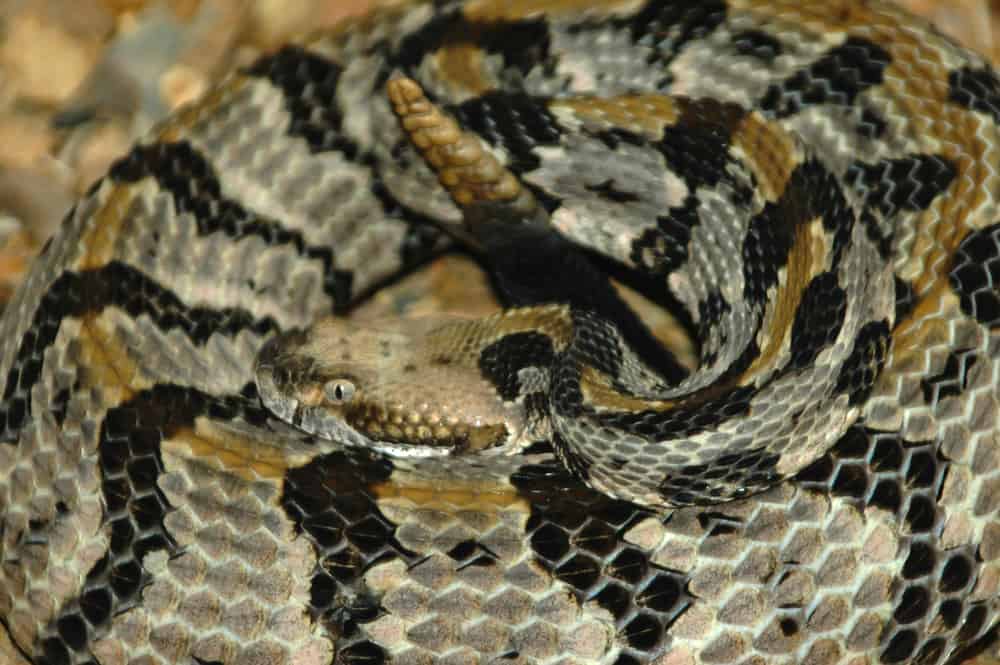
|
Scientific Name: |
Crotalus horridus |
|---|---|
|
Range: |
Western and Central Oklahoma |
|
Adult Size: |
30 inches to six feet |
|
Description: |
The final scales of the tail are adapted to form a “rattle” or sound-producing organ. A strikingly colored snake with a background color of tan or gray-brown. Regular horizontal bands of dark brown or black, and sometimes a light vertebral stripe, complete the pattern. A large, broad head (roughly triangular in shape) with a distinctive tan border around the lips. It has large, slightly domed, eyes with vertical pupils, and big heat-sensing pits between the eyes and nostrils. |
|
Habitat: |
Forests, woodlands, and vegetated hillsides |
|
Venomous/Non-Venomous: |
Venomous |
Western Diamondback Rattlesnakes
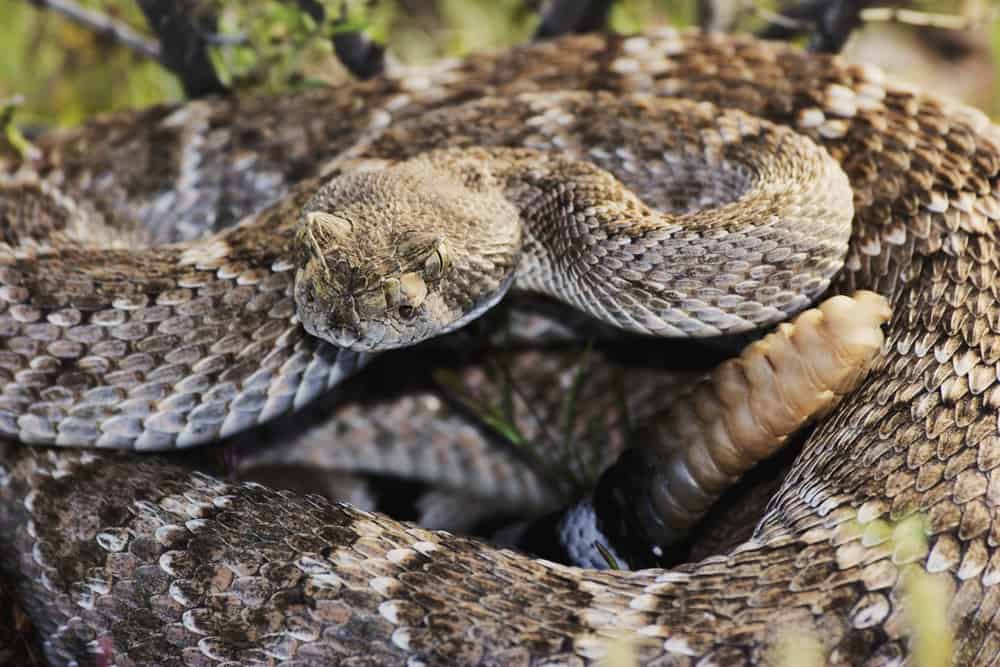
The Western Diamondback Rattlesnakes deserve a special mention as they’re the largest venomous snakes in the region.
|
Scientific Name: |
Crotalus atrox |
|---|---|
|
Range: |
Patchy distribution with populations in part of Western, South-Central, and Eastern Oklahoma |
|
Adult Size: |
Three to seven feet |
|
Description: |
Final scales of the tail adapted to form a “rattle”. The largest rattlesnake in the region, with a robust, well-built body. The snake has a light brown to dark brown background color. Atop the background is a constant pattern of darker brown or black diamonds with a distinct border around each one. The snake’s head is large and wide with a diamond-like shape. Big heat-sensing pits and large horned eyes with slit-shaped pupils complete the picture. |
|
Habitat: |
Diverse, but typically habitats with vegetation |
|
Venomous/Non-Venomous: |
Venomous |
Non-Venomous Snakes in Oklahoma
Oklahoma has so many harmless species that it would be impossible to highlight them all. However, let’s take a look at some of the most intriguing species in the area.
Glossy Snake
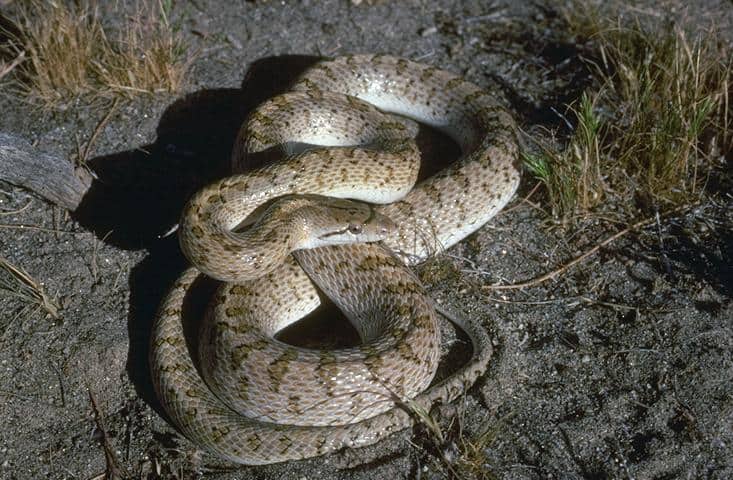
Image credit: CaliforniaDFW (via CreativeCommons.org)
|
Scientific Name: |
Arizona elegans |
|---|---|
|
Range: |
Western Oklahoma |
|
Adult Size: |
20-35 inches |
|
Description: |
A long snake that tapers to a long, pointy tail. The snake’s scales are elongated, almost diamond-shaped, and extremely shiny. The snake is a light tan with darker brown alternating bands throughout the animal’s body. The snake’s head has multiple lines traveling in various directions, as well as several spots – its pupils are round. |
|
Habitat: |
Semi-arid grasslands |
|
Venomous/Non-Venomous: |
Non-venomous |
Western Worm Snake
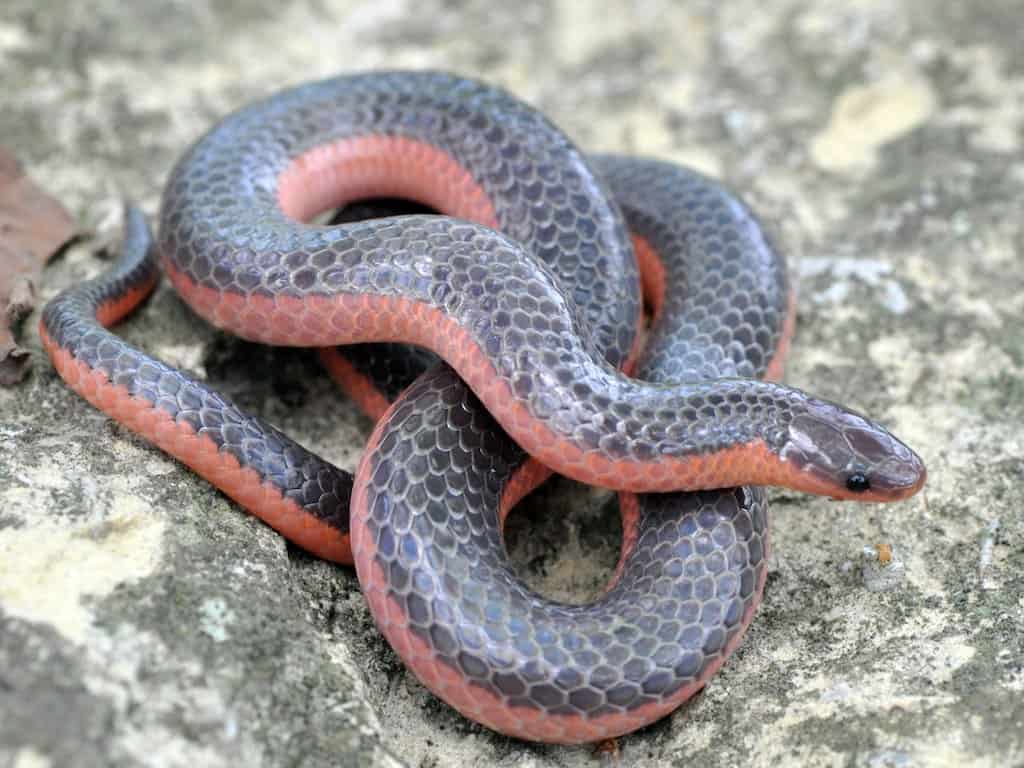
Image credit: smalleraperture (via CreativeCommons.org)
|
Scientific Name: |
Carphophis vermis |
|---|---|
|
Range: |
Eastern Oklahoma |
|
Adult Size: |
7.5-11 inches |
|
Description: |
The tail tapers to a sharp point. The snake has a medium-length head with large, glossy scales and round pupils. A striking snake with a black or brown upperside and a bright red underside that starts in the center of the snake’s side. |
|
Habitat: |
Prairies, savannas, and woodlands |
|
Venomous/Non-Venomous: |
Non-venomous |
Plains Black-Headed Snake
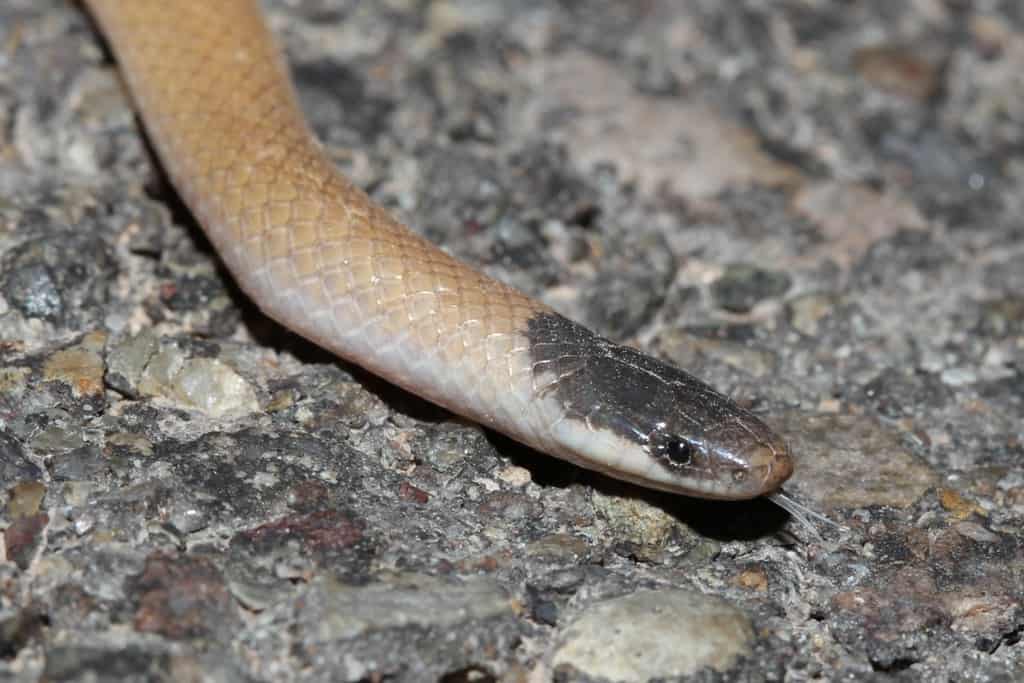
Image credit: aplomado/ (via CreativeCommons.org)
|
Scientific Name: |
Tantilla nigriceps |
|---|---|
|
Range: |
Throughout the state, except the Northwest |
|
Adult Size: |
7.1-15 inches |
|
Description: |
A small, brown snake with a well-rounded body. It has an elongated head with a flattened snout and round pupils. A single black patch covers the head and the front of the neck area. |
|
Habitat: |
Prairies and other habitats with moist soils |
|
Venomous/Non-Venomous: |
Non-venomous |
What You Need to Know
There are several things you should know about snakes to help you deal with them appropriately:
- Snakes consider humans to be predators, not prey.
- Most snakes are as eager to get away from you, as you are to escape from them.
- Snake bites aren’t common, with only around 7,000 recorded for the entire United States every year.
- Of the venomous bites recorded every year, only around five related fatalities occur in the US annually.
- Most snake attacks are the result of someone interfering with a snake, rather than because a snake was simply aggressive.
Snake Safety 101
If you follow some basic precautions, it’s easy to protect yourself from snake bites. We recommend following these simple guidelines:
- Avoid entering overgrown areas with limited visibility.
- Keep your pets on leashes and your children close to you.
- Wear sturdy shoes whenever you enter the potential habitat for a venomous species.
- Stick to well-defined hiking and jogging trails so you don’t stray into the home of a pygmy rattlesnake or other snake species.
- Stay alert and keep a close eye on the places where you’re walking – allowing your mind to wander can be fatal when you’re in pit viper territory.
Above all, never bother a snake in any way. Most of the reported snake bites each year happen when someone tries to catch, kill, or otherwise bother a snake species.
About Venomous Snakes
Most venomous snakes in this region rely on camouflage to protect themselves. This is standard defensive behavior for pit vipers like the prairie rattlesnakes.
Unfortunately, unlike most harmless species, this reliance on camouflage means that pit vipers don’t try to escape, they just stay put. This behavior makes it easy to step on them.
It’s important to remember that even bites from venomous species like timber rattlesnakes are rarely fatal.
Medical advances have brought us to the point where we can counteract most venoms.
However, whenever you’re entering the habitat of a venomous species, try to protect yourself using the tips given above.
Snakes don’t want to hurt you, they’re just hard to see and easy to step on. If you pay careful attention to where you’re walking and don’t bother a snake if you find it, you’ll be fine.
If You Encounter a Snake
When you encounter a snake, you don’t need to do anything.
If you’re too close to the snake, back away slowly and observe it from a safe distance. You can take photos and make observations if you’d like.
Never taunt or bother snakes in any way, and you’re unlikely to have any problems. In the next section, we’ll discuss when to call for help.
When to Call for Help
Very rarely will you need to do anything if you come across a snake. The two situations when you might need to call for reinforcements are:
- When the snake is in danger or poses a danger to someone else.
- When the snake has bitten you, someone else, or someone’s pet.
If you face either of these situations, call for help using the details in the resource section below.
Useful Resources
I’ve constructed a list of useful resources for you to use if you encounter a snake, or want to learn more about these animals.
Emergency Poisoning Advice
Poison Control Center’s national hotline: 1-800-222-1222
ASPCA Poisoning Hotline: 1-888-426-4435
Snake Relocation Services
If you need to relocate a snake, consider using the following resources:
- The Game Warden Directory of Oklahoma will help you track down a warden in your area.
- The Free Snake Relocation Directory group on Facebook can also help you get in touch with freelance snake wranglers.
Educational Resources
There are several excellent educational resources out there to help you learn about snakes in your region:
iNaturalist is a brilliant website that helps you learn about animals and how to identify them. It also offers opportunities for connecting with other wildlife enthusiasts.
The Oklahoma Center for Poison and Drug Information also has a useful guide to venomous snakes.
Related Articles to Oklahoma Snakes Identification Guide
If you’re a traveler, and interested in identification guides for other states, have a look at the following:
- Alabama Snakes Identification Guide
- North Carolina Identification Guide
- Missouri Snakes Identification Guide
You can also check out my other articles about snakes – we have vital guides that you can learn from!
